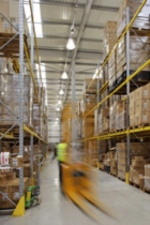Metal halide in a new light

Providing effective lighting from a high mounting position is very demanding on light sources and luminaires. Clive Riddell explains why metal halide is still the best choice for low- and high-bay lighting.
Over the last three to four years there has been a marked increase in the use of T5 fluorescent lighting for low-bay and high-bay lighting. Unfortunately, the decision to use T5 has, in many cases, been based on inaccurate and out of date information. Consequently, the comparisons made between T5 and the alternatives are often erroneous, so the installation fails to deliver the performance the end user was expecting.
On this point, it is important to state that this is not a criticism of T5 lighting systems. It is very clear that they have been a great boon in many office and other applications where modular fluorescent lighting is the obvious choice. However, it is important to bear in mind that a T5 system is more than just a lamp. It is the high-performance reflectors that provide a good light output ratio (LOR), and it is high-efficiency control gear that gives extended lumen maintenance. Such systems are certainly capable of providing an LOR of 90% with an efficacy of 85 lm/W.
Where specifiers are sometimes led astray is in expecting the all T5 systems to deliver the performance of the very highest quality T5 systems.
Furthermore, during the specification process, many comparisons are made with metal-halide lighting of four to five years ago, rather than the metal halide systems that are currently available.
The point is that T5 systems have now become a price-driven commodity item, with considerable downward pressure on prices that, in some cases, has resulted in considerable compromise on the quality of reflectors and control gear. While the lamp itself may maintain an efficacy of 85 lm/W, the LOR in many systems has fallen to 40 to 50%, with a shorter useful lamp life.
In contrast, metal-halide lamps and their control gear have come a long way during this same time period. Consequently, an efficacy of 110 lm/W with an LOR of 90% is now readily achievable. To gain a meaningful picture, it is these systems that should be compared to the current crop of T5 systems.
A metal-halide system with electronic control gear, using the latest reflector technologies, is more than capable of out-performing the very best T5 systems in high- and low-bay applications. If a lower-priced T5 system is being considered to stay in budget, the performance differences will be even more marked.
Just as importantly, it is essential to consider the ambient temperatures of the space being lit. Quoted performance figures for T5 are for ambient temperatures of 25°C, and performance falls sharply either side of this ideal temperature. In contrast, metal-halide lamps are unaffected by ambient temperatures, so the quoted figures apply in all applications.

For example, in a loading bay where the lighting is exposed to winter temperatures, the light output from T5 systems can fall dramatically at the time of year when the days are shorter and the lighting is used most. Metal halide, on the other hand, will provide constant light output all year round.
There are also other details to consider. For example, another characteristic of T5 that has made it popular is the ability to dim T5 lamps, so they can be controlled in relation to variable parameters such as occupancy and daylight levels.
Once again, it is important to look at the current crop of metal-halide systems, where dimming down to 30% of full light output is now possible in all sizes up to 400 W. Consequently, the light output from metal halide lighting is now highly controllable, so that lighting can be dimmed in relation to daylight levels and occupancy — and provide an immediate response to changing conditions.
Among the various high-intensity-discharge (HID) lamps on the market, metal halide has long been recognised as offering whiter colour appearance and better colour rendering, and this is another area that has continued to improve. For instance, our natural white metal-halide lamps offer a colour rendering of 90+ Ra, compared to 85 Ra for T5 lamps.
There is no doubt that T5 systems are usually the best choice for modular recessed lighting in areas such as offices, where ceiling heights are relatively low. But in more demanding high- and low-bay applications, there is no room for compromise, and the specification for each project needs to be considered in the light of accurate and meaningful information.
Clive Riddell is technical manger with Venture Lighting.







